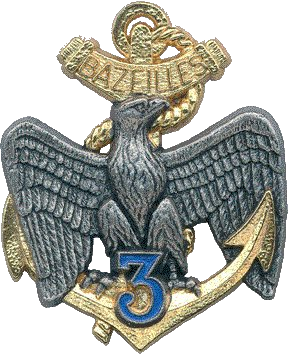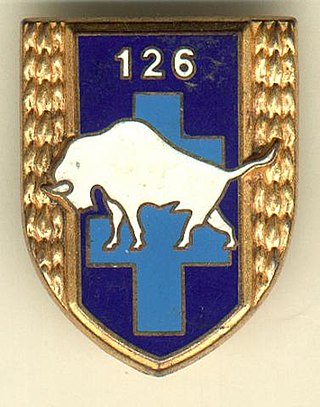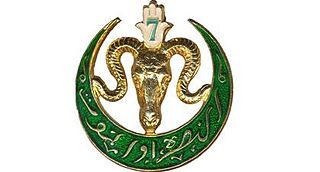This article needs additional citations for verification .(February 2013) |
The 53rd Infantry Division (French : 53e Division d'Infanterie, 53e DI)was a French Army formation during World War I and World War II.
This article needs additional citations for verification .(February 2013) |
The 53rd Infantry Division (French : 53e Division d'Infanterie, 53e DI)was a French Army formation during World War I and World War II.
During World War I, the division comprised:
It was part of the French 1st, 2nd, 5th, 9th, 11th, 13th, 20th, 33rd, 35th and 40th Corps, during which it participated in the Battle of Charleroi, the Battle of Guise, the First Battle of the Marne, the First Battle of the Aisne, the Second Battle of Artois, the Second Battle of Champagne, the Battle of the Somme, the Battle of the Lys, the Battle of Matz, and the Meuse-Argonne Offensive.
At various times, it was part of the French First Army, French Second Army, French Third Army, French Fourth Army, French Fifth Army, French Sixth Army, French Seventh Army and French Tenth Army. [1]
During the Battle of France in May 1940, the division contained the following units:
It was a Series B Reserve division containing older reservists.

The Seaforth Highlanders was a line infantry regiment of the British Army, mainly associated with large areas of the northern Highlands of Scotland. The regiment existed from 1881 to 1961, and saw service in World War I and World War II, along with many smaller conflicts. In 1961 the regiment was amalgamated with the Queen's Own Cameron Highlanders to form the Queen's Own Highlanders, which merged, in 1994, with the Gordon Highlanders to form the Highlanders. This later joined the Royal Scots Borderers, the Black Watch, the Royal Highland Fusiliers and the Argyll and Sutherland Highlanders to create the present Royal Regiment of Scotland.
The 41st Infantry Division was a French Army formation during World War I and World War II.

The Royal Sussex Regiment was a line infantry regiment of the British Army that was in existence from 1881 to 1966. The regiment was formed in 1881 as part of the Childers Reforms by the amalgamation of the 35th Regiment of Foot and the 107th Regiment of Foot. The regiment saw service in the Second Boer War, and both World War I and World War II.
The 19th Army Corps was a corps of the French army. In December 1870, the Tours delegation created the 19th Army Corps which was formed in Alençon. It was recreated by decree of the JO of August 13, 1874, it brought together the various military units of Algeria. It constituted the nucleus of the Army of Africa.
The Tenth Army was a Field army of the French Army during World War I and World War II.
The 2nd Army Corps was first formed before World War I. During World War II it fought in the Campaign for France in 1940 and during the 1944–45 campaigns in southern France, the Vosges Mountains, Alsace, and southwestern Germany. It was active under the First Army for many years after World War II.
The Armée d'Orient (AO) was a field army of the French Army during World War I who fought on the Macedonian front.

The 1st Marine Infantry Regiment is a French regiment heir of the colonial infantry. The regiment is one of the quatre vieux regiments of the Troupes de Marine, with the 2nd Marine Infantry Regiment 2e RIMa, the 3rd Marine Infantry Regiment 3e RIMa, as well the 4th Marine Infantry Regiment 4e RIMa. Along with the 1st Marine Artillery Regiment 1er RAMa and the 2nd Marine Artillery Regiment 2e RAMa, the 1st Marine formed the Blue Division. The 1er RIMa is a light armoured unit, since 1986, alike with the régiment d'infanterie-chars de marine RICM.

The 3rd Marine Infantry Regiment is a unit of the French Army. The 3e RIMa is one of the oldest of the troupes de marine. This regiment is one of the "Quatre Grands" of marine infantry once garrisoned within the four military ports, ready to embark : the « Grand Un », the « Grand Deux », the « Grand Trois » and the « Grand Quatre ». The regiment fought in the expeditions of the 19th century in Africa, the Americas, Oceania and the Orient. Surnamed also the "3rd Marine", the unit was part of the « Blue Division » which fought at the Battle of Bazeilles on August 31 and September 1, 1870. The regiment is part of the 9th Light Armoured Marine Brigade.
The French 2nd Infantry Division was one of the oldest divisions of the French army.
René Jacques Adolphe Prioux was a French general who served in both world wars. A cavalry officer of great talent, Prioux rapidly rose through the officer ranks and commanded the Cavalry Corps of the First Army during the Battle of Belgium in May 1940. He was captured by the Germans and spent two years as a prisoner of war. Repatriated in 1942, Prioux came to be seen as a strong supporter of the Vichy regime and was consequently removed from a position of authority in the French Army by Charles de Gaulle, the leader of the Free French, after the landings in French north Africa by U.S. and British forces in November 1942.

The Battle of Monastir (1917) was a failed French attack against German-Bulgarian fortifications North and West of Monastir, between 12 March and 26 May 1917, during the Salonika Campaign in World War I.
The Moroccan Division or the 1st Moroccan Division of 1914, initially the Marching Division of Morocco was an infantry division of France's Army of Africa which participated in World War I.

The 126th Infantry Regiment is a regiment of the French Army. It was first constituted during the French Revolution.

The 7th Algerian Tirailleurs Regiment was an infantry unit of the French Army, part of the Army of Africa.

12th Infantry Division was an infantry division of the French Army which took part in the Napoleonic Wars, World War I and World War II. It fought at the Battle of the Nations in 1813. It was converted to a motorised infantry role at Mourmelon-le-Grand in 1939 a few days before the French declaration of war on Germany and renamed 12th Motorised Infantry Division
156th Infantry Division was an infantry division of the French Army during the First World War. It was deployed overseas, seeing action during the Gallipoli campaign, and thereafter on the Salonika front, fighting alongside British troops in both theatres of war. It was sent to the Crimea in December 1918 as part of the Army of the Danube.
122nd Infantry Division was an infantry division of the French Army during the First World War. It was deployed overseas, seeing action on the Salonika front, fighting alongside British troops. It was sent to the Crimea in December 1918 as part of the Army of the Danube.
57th Infantry Division was an infantry division of the French Army during the First World War. It was deployed overseas, seeing action on the Salonika front, fighting alongside British troops. It was sent to the Crimea in December 1918 as part of the Army of the Danube.
17th Colonial Infantry Division was an infantry division of the French Army during the First World War. It was deployed overseas, seeing action during the Gallipoli campaign, and thereafter on the Salonika front, fighting alongside British troops in both theatres of war. It was sent to the Crimea in December 1918 as part of the Army of the Danube.